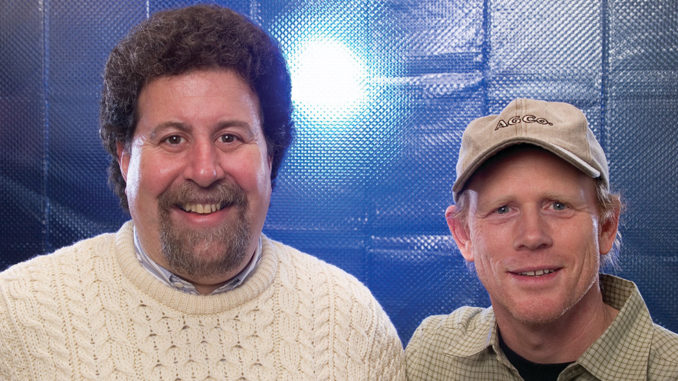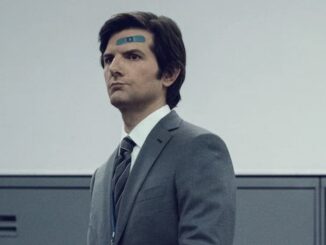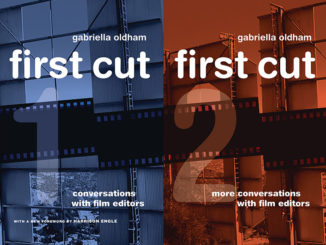
by Kevin Lewis
Cinderella Man, starring Russell Crowe and Renée Zellweger, is the remarkable and unbelievable true story of James Braddock, the New Jersey-born boxer with the healed broken hand who became the heavyweight champion of the world in 1935. The Gotham folklorist/sportswriter Damon Runyon gave him the moniker “Cinderella Man” because Braddock was one of those forgotten men of the Depression who almost lost his family because of crushing poverty. For director Ron Howard, this is the closest he has come to making an existential film–despite its upbeat Capraesque ending–which is well in tune with the archetypical American filmmaker of the Depression.
Even his longtime sound and picture editing team, one of the longest association in the business, notices this change and applauds it. A Beautiful Mind (2001), for which he won the Directors Guild of America award and the Academy Award, began this change, but the elements for this disabled character were always present in Howard’s ouevre, all the way back to one of his initial directing efforts, the television movie Skyward (1980), in which a paraplegic girl becomes a pilot.
Howard didn’t know what a Waterloo he faced when he decided to direct Bette Davis as the reclusive aviatrix who teaches the determined paraplegic to fly. Even before they met, Davis tried to psych him out. After she repeatedly called him “Mr. Howard” during their telephone conversations, he asked her to call him Ron. Recalling the incident, he remembers her saying, “‘I will call you Mr. Howard until I decide whether I like you or not,’ and then hung up. I had a sleepless night after that call.” Even for Davis, this was pathological behavior toward someone who a doting America had watched literally for most of his then 25 years in such hit sitcoms as The Andy Griffith Show and Happy Days, plus the movies The Music Man (1962) and American Graffiti (1973).
The same loyalty that his crew gives him, Ron Howard gives back in trust, respect and collaboration.
Thinking that he would inspire trust in the old queen of Hollywood, he showed up on the first day of shooting in a jacket and tie, incongruous in the New Hollywood and certainly on a sweltering summer day in Texas, but in tune with what Howard thought such Golden Age directors as Howard Hawks and Frank Capra would do. Davis, who put Joan Crawford in the hospital and delighted in devouring directors, inquired airily to the crew who this child was approaching her. Howard eventually gained her trust, and she gave one of the best performances of her later career.
“That experience was almost a watershed moment for me–directing her, the tone of the film–there was a naturalism in places that I hadn’t really directed and staged before.” He admits that directing the veteran star gave him the confidence to direct the legendary stars in Cocoon (1985). Not to mention Crowe, whose great emotional range and temperament is a match for Davis’.
One thing Howard learned: was that he would never treat any of his crew in that manner. The filmmaker has kept his production team of sound and picture editors–all of whom are gifted enough to work for other directors–together by supporting their efforts and creative input. If the director is considered to be the general on a film, then he has succeeded by being an Eisenhower rather than a Patton. In interview after interview, the same story emerges of technicians with ribbons to show rather than battle scars. The same loyalty that they give him, he gives back in trust, respect and collaboration. His editors have been honored with awards by the Academy of Motion Picture Arts and Sciences, the American Cinema Editors (ACE), the Cinema Audio Society (CAS) and others.
Perhaps Howard is wiser and more suited to the entertainment industry than many of his colleagues because he started at the top with an incredible spectrum of stars and directors known for their longevity–Andy Griffith, John Wayne, Lauren Bacall, Shirley Jones, James Stewart, Henry Fonda (who presented him with The Cinematographer’s Manual when he enrolled in the filmmaking program at the University of Southern California after Fonda played his father in a short-lived TV series), Don Siegel, Roger Corman and George Lucas–but he learned from all of them how to treat people. Unlike many child stars, Howard had a stable childhood, and his father, actor Rance Howard, who co-wrote his early directorial efforts, is still a part of his professional life.
Even though he downplays it, Howard knows more about the changing technology than he lets on, at least according to his post-production crew.
Though he is not thought of as a Roger Corman alumnus, Corman financed Howard’s first directorial effort, Grand Theft Auto (1977), the success of which prompted NBC to sign him to direct three of its movies-of-the-week, of which Skyward was one. Over the last quarter century since then, he has directed a series of films which produce millions of dollars a year in revenue because of their timeless appeal: Night Shift (1982), Splash (1984), Cocoon (1985), Far and Away (1992) Apollo 13 (1995), A Beautiful Mind (2001).
In Braddock, the prizefighter who is almost defeated by the economic hopelessness of the Great Depression, Howard has created a microcosm of a humbled, despairing America. The “have-nots” appealed to Howard, who played a migrant in The Migrants, 30 years ago. When Crowe first gave him the script, Howard realized that Crowe was the only actor who could bring the authentic period feeling that the film needed to make audiences feel the despair of the Depression.
“I have had a long fascination with the Depression, really going back to high school,” he reveals. “My first lengthy film project [28 minutes] was a documentary I did for a high school history class, where I interviewed people who had lived through the Depression. My own family were not victims of the Dust Bowl, but they came from Oklahoma and Kansas and everyone struggled.” Through Studs Turkel’s book Hard Times, Howard learned about its devastating effects in the big cities. “I felt that it was a great opportunity to deal with a great story that presents the possibility of hope and celebrates one family’s survival. But it acknowledges the loss and pain and struggle of so many people who didn’t make it,” he says.
“With each film I try to let the environment, the themes and the overall demands of the story define what it is going to look and sound like, as opposed to conform it in any way to anything I have done in the past.” he explains. Though Cinderella Man is in color, Howard manages to evoke the stark black-and-white Walker Evans photographs of the era by desaturating the color and using low-key lighting. “Late in our research, we found some color photographs of the period,” he says. “That was really helpful because it reminded us that people were trying, that there was some color. You could see by the clothing that it was worn and tattered but they were hanging on to every optimism and energy that they could. It is one of the things that is inherently noble in retrospect about the period. The average people tended to cling to their morality, cling to their dignity as long as they possibly could.” (Historical note: The late 1930s Technicolor movies were usually costume dramas, musicals or comedies. Though Nothing Sacred [1937] is set in the Depression in New York, it is a very clean, shiny Big Apple that is depicted.)
“Some of the sounds that [Chic Ciccolini] reaches for–certainly have nothing to do in any literal sense with what the scene is about, and yet quite often those choices are really an enhancement and reach the audience’s psyche in a significant way.” – Ron Howard
Howard is comfortable with his crews because of his unique background; he observed the technical crews of films in the last days of the studio system, which were in the television studios. “I absolutely grew up in that environment and the feeling, particularly on the set of The Andy Griffith Show, was very familiar and collaborative,” Howard says. “Everyone had a voice, everyone’s opinion counted, even beyond their area of expertise. If the boom guy thought something wasn’t funny, he could say something, and it was okay.
“I grew up fascinated by all the jobs everyone did, and I came to respect various department heads as experts,” he continues. “I always developed my own approach from the perspective of an actor. I went to film school and made my own films, edited films, worked Moviolas and exposed film. I am not technically oriented and so I don’t believe for one minute that I can do [supervising sound editor] Chic Ciccolini’s job better than he can do it. I am the guardian of the story, so that’s what I have tried to make myself expert at, and so I know what it is we need, and I know how to communicate those ideas.”
Although he doesn’t think he’d make a great sound designer, “I know when the possibilities of a scene are or are not being realized in terms of sound, and how to ask the questions,” Howard says. “But with this team, I don’t have to do much of that. I show them the film and I initiate conversation, and it gets creatively exciting very quickly.” And even though he downplays it, Howard knows more about the changing technology than he lets on, at least according to his post-production crew. The majority of his films since 1985 have been finished in New York, and have used the same sound editing team.
“We have a fantastic rapport in the editing room,” Howard says about picture editors Dan Hanley and Mike Hill. “They are very performance-oriented, in terms of the editorial choices that they make. By now of course it’s a great shorthand. People joke that when we are watching dailies together, there are no complete sentences–a few odd words and a couple of grunts–and Dan and Mike are taking notes and everything seems to be understood. It’s a great collaboration. They remain excited about movies, they become passionate about a story’s potential. They have good taste and our aesthetic is just similar enough and just dissimilar enough that good ideas emerge from the collaboration.”
If the director is considered to be the general on a film, then Ron Howard has succeeded by being an Eisenhower rather than a Patton.
Ciccolini began his stint with Howard on Gung Ho (1985). “Chic is a fascinating guy because he’s incredibly ambitious creatively. He lives and dies for the movies and television shows that he works on,” raves Howard. “He’s never phoned in a day’s work in his life. As a result, there are just a lot of great nuances. He’s very much motivated by story, and doesn’t try to overpower a scene with a notion that will distract. He wants to enhance, but some of his sources–some of the sounds that he reaches for–certainly have nothing to do in any literal sense with what the scene is about, and yet quite often those choices are really an enhancement and reach the audience’s psyche in a significant way.”
Of his sound editors as a group, Howard says, “Sometimes I have very concrete ideas. They’re eager to hear those and respond, but often I like to see what they can come up with.” In short, he’s reinforcing what he observed as a child on those television stages 40 years ago. “I’m also encouraging everybody to take risks.
“With digital editing, the sound design questions are asked much earlier than they used to be, and it’s really great,” he continues. Hanley and Hill will do a temp dub for Ciccolini, who then offers his own suggestions. The assistant picture editors also contribute their ideas. “Instead of building a scene more literally on what you see and hear on the soundtrack, Mike and Dan can begin editing with the idea that a key sound effect could actually tilt the scene in a new direction,” Howard explains. “We sort of guessed at that before and now you can be much more certain that such an idea is workable. You are much less on pins and needles when you get to this [post-production] phase because you’ve massaged it, you’ve worked on it, you’ve done a temp mix as you’ve edited the film.”
Searching for the authentic sound which captures precisely the emotion or the realism of the story is a painstaking but worthwhile process for Howard: “It’s just as exciting to hear the final mix and see it come to life in a way that’s in fact subtle–so subtle that all the hard work might go unnoticed–but deeply meaningful in what the audience is going to experience.”
What Howard demands of his team is simple. “Everyone involved in my films–the ones who stay–are the ones who connect themselves emotionally to what the characters are going through, because that’s what I’m always trying to ask the audience to invest in. What’s the journey like? What are these characters living through? What’s it like to be in their shoes?





